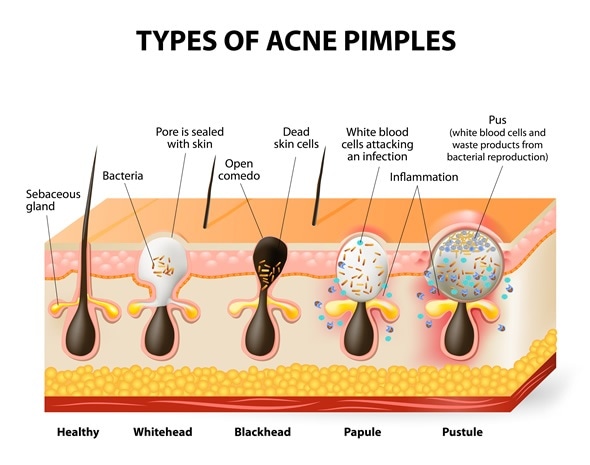
Acne and Make-Up
Acne is the most common skin condition to affect human beings. It is a disorder of the pilosebaceous units of the skin, which includes the hair follicle with its canal, and the attached sebaceous gland. The pathogenesis of acne may include more than one factor:
- Overproduction of sebum
- Overshedding of keratinocytes from the lining of the hair follicle
- Growth of Propionibacterium acnes in the hair follicle
- Inflammation around and inside the hair follicle
The condition is most common in adolescence, but can strike at older ages as well. Approximately 80% of teenagers suffer from acne at one time or the other. Young males usually have the more severe form of acne, but girls and women are the major demographic affected. Even young adults develop acne, with about 40% of people over 20 years being affected. A few people report the first onset of acne after the age of 25, which is called adult-onset acne.

Types of acne pimples. Healthy skin, Whiteheads and Blackheads, Papules and Pustules - Image Copyright: Designua
Factors Affecting the Development of Acne
While many factors have been reported to cause or aggravate acne, some of them have been proven to be linked with the condition, such as:
- Genetics - there is a strong link between the development of acne in an individual and an existing family history of it.
- Hormones - androgens are linked to the emergence of acne as they promote sebum production. Women often report acne that erupts around the same period of their menstrual cycle, in the first few months of pregnancy, or in the medical condition called polycystic ovarian syndrome in which androgen levels are often elevated.
- Stress - while stress does not cause acne to develop, it may worsen the condition.
- Medications - certain drugs such as oral contraceptives, some anticonvulsants and antidepressants may trigger attacks of acne.
- Friction - skin friction, resulting from an article such as a tight vest, a headband, or a backpack strap, may aggravate acne.
- A high level of environmental pollution.
- A humid or greasy atmosphere - this encourages excessive sweating or oil deposition on the skin.
Acne is not caused by:
- Having oily or greasy skin - by itself, this is not linked with acne in all such individuals.
- Eating fried foods - while this kind of diet may increase your waistline, it has not proved to be associated with increased acne development.
- Having hairstyles in which hair falls over the face - this used to be blamed for acne, but is likely not responsible as long as the hair is not greasy or pomaded.
Makeup and Acne
Makeup includes a wide range of products such as conditioner, foundation, blush, face powder, and lipstick. Former makeup was heavier and often oil-based, which led to blockage of the skin pores and an increased occurrence of acne. However, the so-called acne cosmetica which was a form of acne found on the cheeks and forehead of women who used makeup is thought to be unassociated with the condition. Rather, the link may be because these women use makeup to disguise the scars or lesions of acne.
Modern cosmetics are non-comedogenic; they are water-based and oil-free. Thus they do not contribute to plugging of the follicle openings from the outside, leading to the accumulation of sebum. Even this type of makeup, however, should be removed carefully before bed with a mild cleanser, using a soft wipe or other gentle cleansing agent. Makeup should never be scrubbed off the user’s skin is prone to acne.
If any specific type of makeup results in an acne flare-up, it is best to avoid that product.
Benefits of Makeup in Acne
Makeup is often used to disguise acne lesions while treatment is underway. Several studies have shown that appropriately used cosmetics designed for use by persons with acne not only increase the quality of life to a significant extent, but actually decrease the number of acne lesions during the period of cosmetic use.
Acne is often distressing because, in the mind of the person, it leads to disfigurement of the face. Acne may lead to greater emotional pain, difficulty in many areas of social interaction, poor body image, and a lowering of self-esteem in fragile individuals, seen especially in females. Depression is often a consequence. Since proper instruction in the use of makeup can help to alter the quality of life significantly, it should be recommended by dermatologists for patients who need it. Not only can its use boost psychological health by improving the appearance of acne-affected skin, it can also increase the rate of compliance with treatment regiments.
The important benefits of using suitably designed makeup in acne include:
- Imparting an even tone to the complexion, thereby helping the individual feel more satisfied with the skin appearance
- camouflaging acne blemishes partly or completely
- High tolerability
- Lowering of the rate of new lesions
- Increasing the rate of completion of medical treatment of acne
- Significantly improving psychological health parameters and quality of life
The disadvantage of using makeup to cover acne lesions includes the pressure to constantly camouflage them - once this practice is started, it may inhibit the freedom to appear in public without makeup.
References
- https://www.ncbi.nlm.nih.gov/pubmed/16048760
- https://www.ncbi.nlm.nih.gov/pmc/articles/PMC5066693/
- https://www.ncbi.nlm.nih.gov/pubmed/17073988
- http://www.jle.com/fr/revues/ejd/e-docs/make_up_improves_the_quality_of_life_of_acne_patients_without_aggravating_acne_eruptions_during_treatments_266141/article.phtml
- https://www.womenshealth.gov/publications/our-publications/fact-sheet/acne.html
- https://www.betterhealth.vic.gov.au/health/conditionsandtreatments/acne
- https://www.girlshealth.gov/body/grooming/acne.html
Further Reading
Last Updated: Jan 25, 2019






















.png)










No hay comentarios:
Publicar un comentario